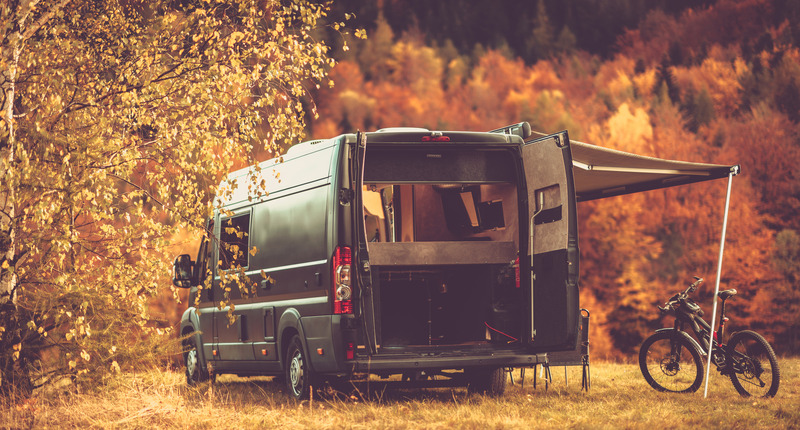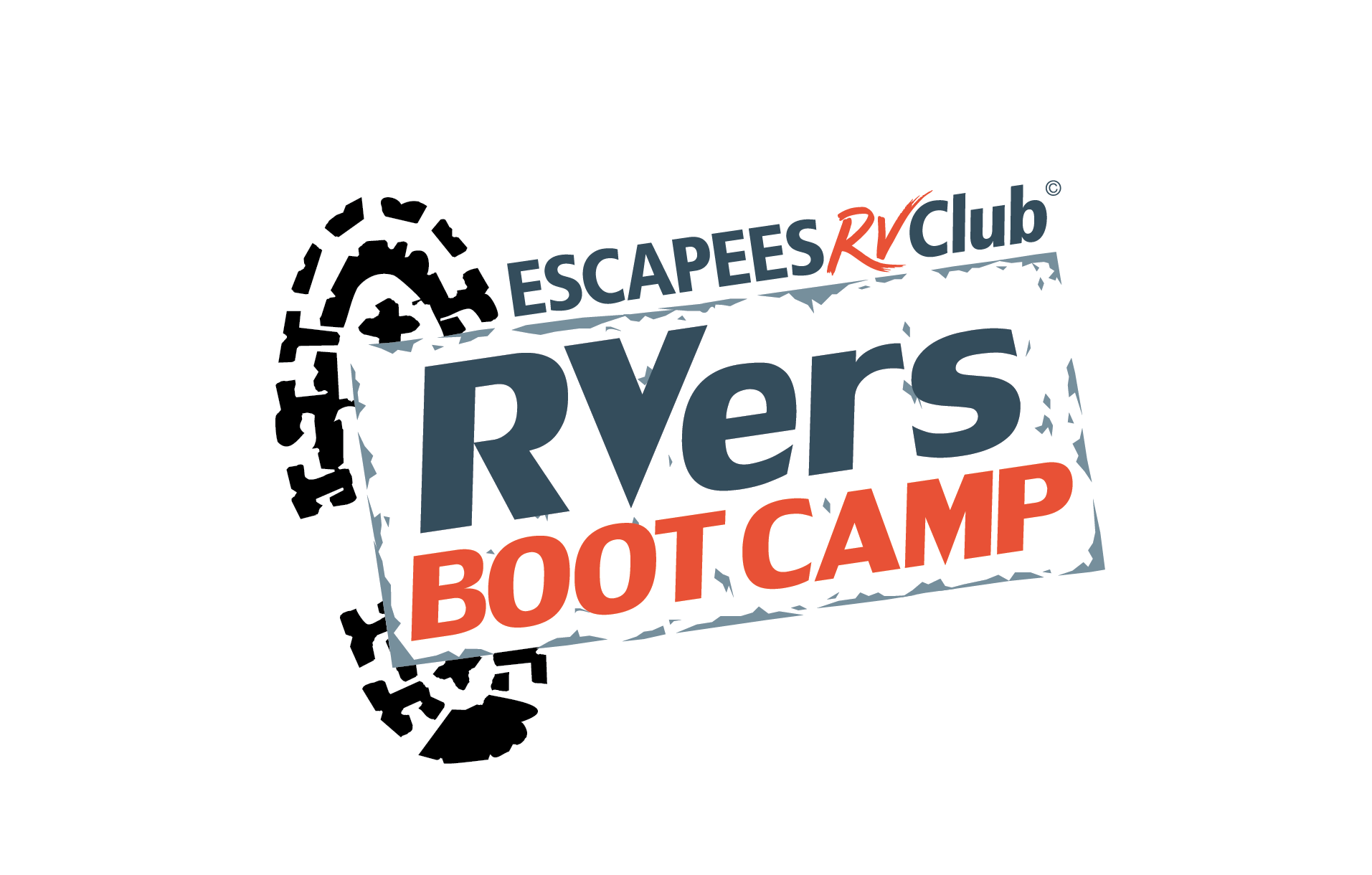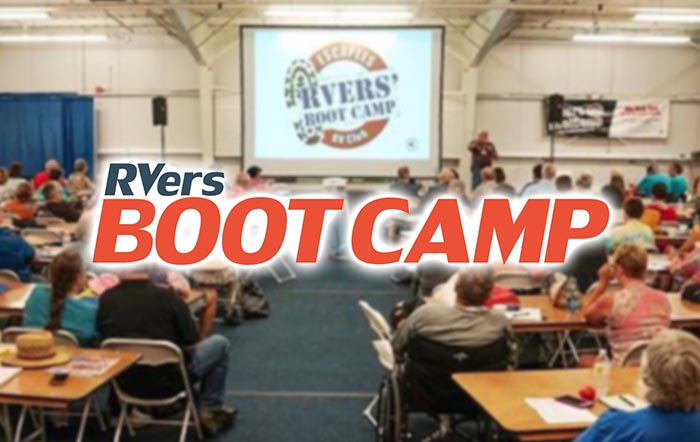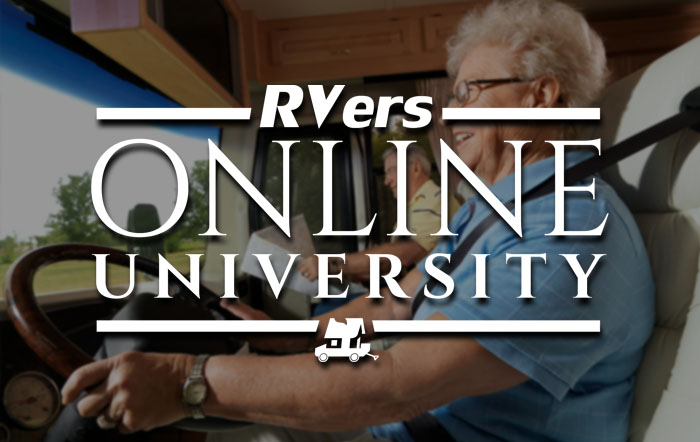You have your RV and you want to take it places where there are million-dollar views, skies that are so dark at night you can see stars for miles, and maybe there is a camping neighbor or two, but they are far off in the distance.
How do you get all these things? You go boondocking!
First, What Is Boondocking?
There isn’t one, agreed-upon definition for boondocking. Generally speaking, boondocking is parking or camping overnight where there are no hookups. It’s also known as dispersed camping.
There is no water, electricity to plug into, or sewer hookup for you to utilize as you would in an RV park or campground.
We want to keep RV boondocking for beginners simple and easy to understand so for the purposes of this article, we’ll define boondocking as camping outside developed campgrounds in remote locations. You will not have water, electric, or sewer hookups and will most likely be camping for free on public lands.
Where Can You Go Boondocking?
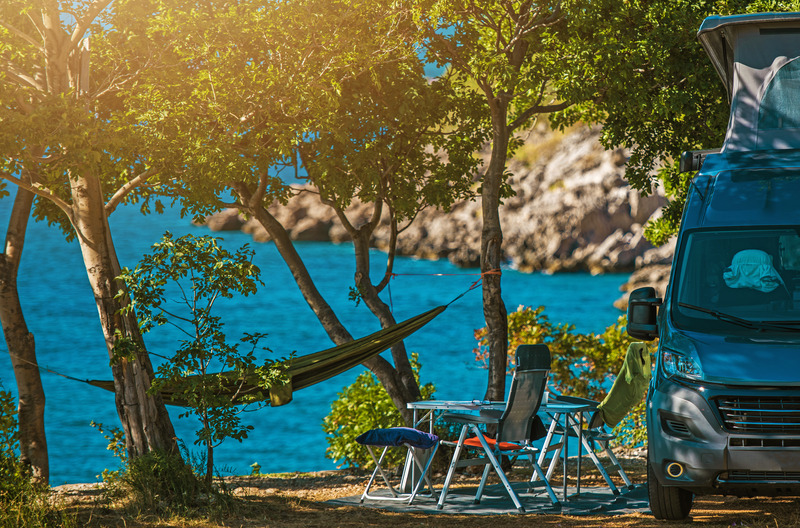
National Forest and Bureau of Land Management (BLM) lands are used the most because they offer many primitive, dispersed camping locations for RVers. Boondocking on these lands gives you the freedom to explore nature right out your door, and it’s free.
There are rules to follow when choosing to boondock on these public lands. Here are only a few of the more general rules, so you need to find out if there are rules specific to the area you wish to stay:
- Camping within a specified distance from a body of water is prohibited (varies by location and agency).
- Be sure to only camp in previously used camping sites. Do not blaze your own trails to create new campsites.
- If you pack it in, you must pack it out.
Many RVers who are beginning their journey into boondocking often ask how spots are found. Fortunately, there are plenty of others who have gone before and have posted their locations and experiences in apps and on websites that list boondocking spots.
Apps and Websites to Find Boondocking Spots

Technology advancements have made finding boondocking spots easier than ever. Here is a list of apps and websites to help beginners find the perfect boondocking spot.
Campendium
You can easily search for boondocking sites by using a text search to focus in on the area you want to camp. Then select the category “All Public Lands” and “Free” for price. You’ll get a list of free camping reviewed by other RVers and campers that will include RV length, road conditions, cell service and coverage, and more.
The Dyrt
The Dyrt website and app allows you to use a free version or the paid, Pro version. Using the free version you can filter by location, site type, site features, user ratings, air quality, and max vehicle length. If you want more filters such as their free camping collection which includes over 5000 drive-in-accessible locations, dump stations, freshwater filling locations, and cell service quality you need to purchase their Pro version.
iOverlander
The iOverlander app and website is free for users and mostly run by volunteers. Users type in a location, filter by place types, required amenities, and the time period places were last visited. When looking for boondocking options, click on “Wild Camping” under “Place Types.”
Overnight RV Parking
Part of the Roadpass Pro group, Overnight RV Parking is a paid service only. However, it gives multiple types of overnight boondocking options, including BLM land and National Forest land.
For even more information, you can contact the nearest Forest Service or Bureau of Land Management office.
7 Things To Know About Boondocking For Beginners
Power and Electricity-
When you are boondocking, you are relying only on your battery power or power generated by your onboard or portable generator. Many items in your RV such as the lights and hard-wired safety alarms (propane detector, CO detector, and smoke detector) are only powered by your house batteries.
So how do you keep these house batteries charged? If you have a portable generator, running it while your RV is plugged into it will charge up the batteries. The same goes for your onboard generator, although it’s already set up to charge your house batteries without having to run a separate cord from your RV to the generator.
Using the power of the sun is another way to charge your house batteries while you are boondocking. You can choose to install an entire RV solar system or you can use the one the manufacturer may have installed during production.
There are many RV solar system consultant and installation companies to help you with the type of system you will need. The type of RV solar system you get is determined by what you think your power usage will be while you are boondocking.
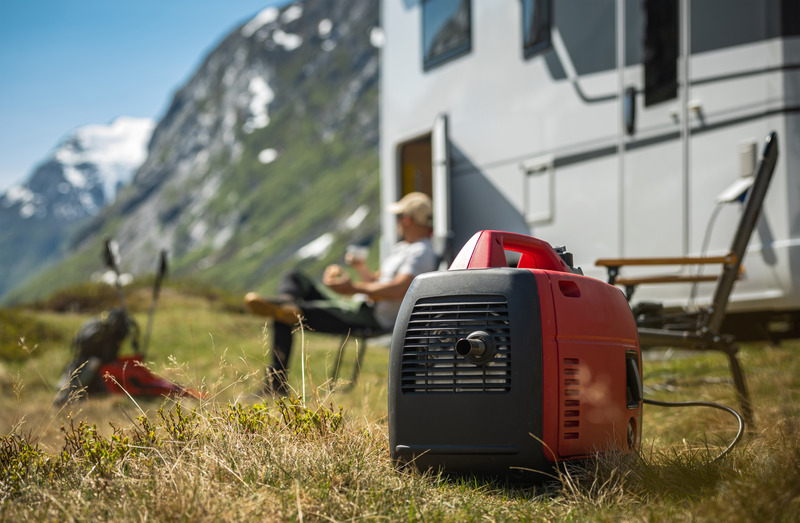
If you choose to only use a generator to charge your batteries, you need to maintain it just like every other system in your RV. Oil and filter changes every 50 to 200 hours, along with running your generator under a load every month for 20-30 minutes will keep a generator operating well.
Battery maintenance and care is very important too, no matter what kind you have. You don’t want to “kill” your batteries by not following the manufacturer’s directions for their care or doing no maintenance what-so-ever.
Flooded lead-acid batteries need the most maintenance. They need to have their distilled water topped off so the cells remain covered. Exposed cells are damaged cells. This will destroy your batteries or at the very least shorten their lifespan.
These batteries need to stay charged as well, even when your RV is in storage. Disconnect them and connect them to a trickle charger. You don’t want to take your RV out of storage to go boondocking and have to buy new batteries every time.
Sealed batteries do not need water. Their cells are sealed. However, they do need to be charged and that is really all you need to do to give these batteries a long life, making them great for boondocking. Simply disconnect them from your RV and connect them to a trickle charger when stored.
Lithium-ion batteries have become a go-to for RVers who boondock. They require little maintenance but do need to be kept at temperatures above freezing.
When storing your RV, it’s recommended that these batteries be disconnected from anything that may draw power from them, stored with at least a 50% charge, and at temperatures that will not get below freezing.
For more information about getting power while boondocking, take a look at our Boondocker’s Digest Series.
Conserving Water
Water conservation while boondocking is pretty easy. You’re going to be using the water from your RV fresh water tank for washing dishes, brushing your teeth, bathing, flushing your RV toilet (if you do not have a composting toilet), and possibly cooking.
One way to conserve water is to turn off any running water immediately after you are using it. While brushing your teeth, only keep the water running when you need to dampen and rinse your toothbrush and when you rinse your mouth. You may even need a little water to rinse out the sink. Other than that, there should be no running water.

The same goes for washing dishes. First, wipe off any food from plates, bowls, and pans with a paper towel and throw that in the trash. Then, fill your sink with a minimum amount of soapy water. Or, you can use a spray bottle with a dishwashing solution (water and dish soap) to spray each item you are washing, and not even fill your sink.
After scrubbing your dishes, use a trickle of water from the sink to rinse them instead of a full stream of water and turn off the water after each item that’s rinsed.
When showering, you can minimize water use by taking a “Navy shower.” This just means you only turn on the water to rinse your body.
You first get yourself wet. Then, you turn off the water while soaping up and scrubbing and only turn the water back on to rinse off the soap and shampoo. You still feel clean and you have barely used any water at all!
Water needed for cooking and drinking while boondocking can be separate bottled water brought with you. This way, you will not use water from your RV fresh water tank, leaving more for washing dishes, showering, and brushing teeth.
Waste Water Management
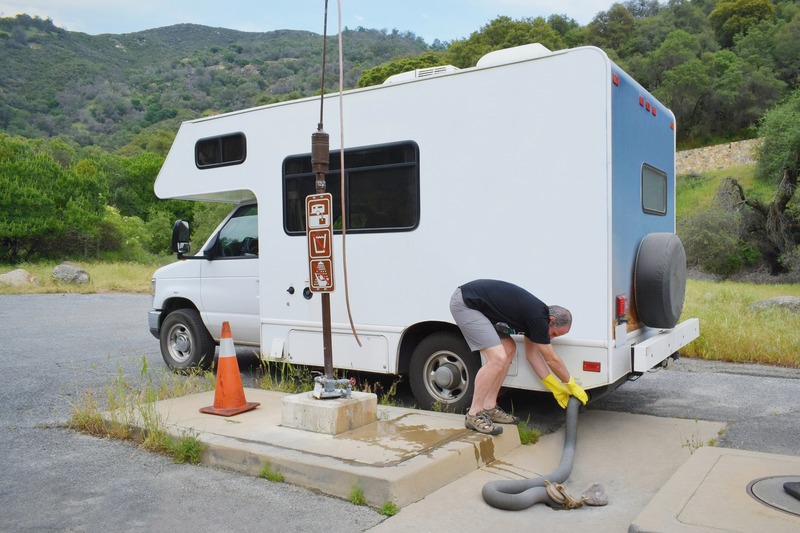
Not only do you need to conserve how much water you use, you need to be aware of how much waste water and human waste goes into your RV waste tanks. If you conserve fresh water, your waste tanks will not fill up very fast.
Your gray water tank is the one that holds waste water from your sinks and shower. Your black water tank holds human waste from the toilet (if you do not have a composting or other type of toilet).
This waste water is only stored in those tanks and will eventually need to be dumped into an approved dump station. Never, ever dump the contents of your black tank onto the ground. This waste water is raw sewage and is considered a biohazard. It is illegal and never allowed, no matter where you are.
In rare instances, gray water can be emptied onto the ground, but only if it is legal in the area you want to dump it, there are no food particles in the waste water, and there are no harmful soaps or chemicals in the waste water.
It is your responsibility to find out where you can dump your gray water. Never dump it on the ground unless you are 100% certain you are following all the rules for the area you are staying. You can find out this information from any of the organizations, such as the Bureau of Land Management and Forest Service, that oversee the use of the land where you are boondocking.
Finding dump stations has become increasingly easier with apps and dump station websites. Campgrounds, RV parks, gas stations, truck stops, water treatment plants, and rest areas are all good places to check for dump stations. Some are free while others will have a fee. Use the apps listed above in the section about finding boondocking spots, along with websites such as rvdumps.com and rvdumpsites.net, to find the nearest dump station.
Garbage Management

What do you do with the garbage you produce when boondocking? Public lands where it is acceptable to boondock have a “pack it in, pack it out” policy. This means that whatever garbage you produce while you’re boondocking needs to be packed out when you leave.
This includes the waste some RVers produce when they use a composting toilet, bucket toilet, or other type of toilet that does not drain into a black water waste tank.
If you wait to take your trash with you at the end of your boondocking adventure, you will need to figure out a place to put it so that it is not inside your RV living space nor left on the ground outside your RV until you depart.
Many RVers have a separate vehicle to tow their RV or is towed behind their RV. This is a great place to keep trash locked up until your next trip to a dumpster or trash can. You don’t want critters to get into your garbage. It’s dangerous for you and for them.
If you don’t have this option, then you will need to figure out the best place to keep full bags of trash until you leave. This may be in a storage bay, hung safely away from animals (from a tree branch far out of reach of animals like bears), or some other spot inside of your RV.
When seasoned boondockers talk about RV boondocking for beginners they will tell you that getting rid of garbage is the hardest thing to do if you don’t have a home base to return to.
You can always visit a landfill or garbage transfer station to get rid of your trash. Unfortunately, there isn’t always one nearby or along your travel route, so these seasoned boondockers suggest keeping your garbage in smaller bags, like grocery bags. This way, you can take a bag or two with you when sightseeing or getting groceries and fuel, and when you see a public garbage can or dumpster you can place your garbage into it.
Do not abuse this option by filling up an entire garbage can. If there isn’t room for all your trash, take it with you and throw it away when you come to another, more empty, public garbage can.
Never throw your trash in the garbage can or dumpster of a homeowner or business without asking and always follow signs that say no household garbage allowed or no dumping allowed.
Download The RVers Boondocking Policy Here:
Scouting Potential Spots
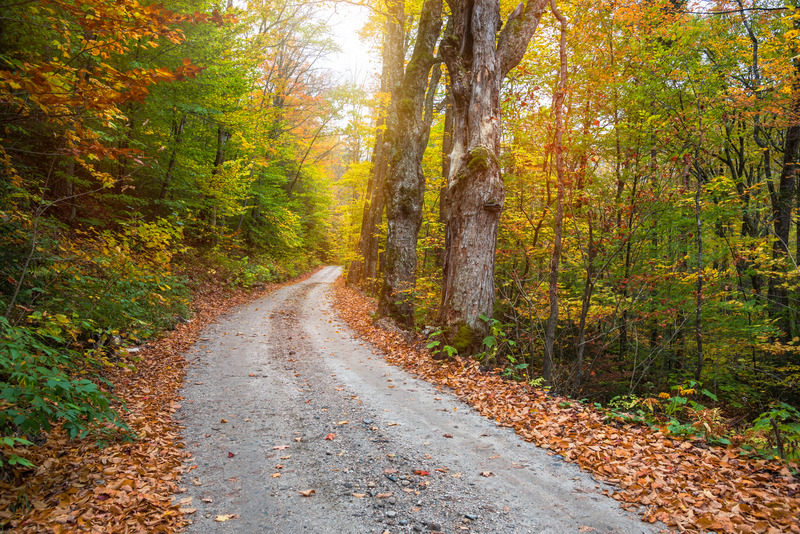
You now know where you’re going and you have come to the road you are supposed to take to get to your boondocking spot. The road doesn’t look like it did in the pictures reviewers left in the app where you found the spot. Now what?
Here’s where you need to scout out a spot by driving the road without your RV. If you have a tow or towed vehicle, unhook it in a safe spot and take it down the road to make sure the road is passable.
Look for large potholes, deep ruts, and road blockages by water, rocks, or logs- basically anything your RV cannot travel over or through. If the road is passable, then come back, hook back up and go find your boondocking spot. It’s not the most ideal way to scout, but it is the best way to get firsthand knowledge of a site.
If the road is not passable, then you will need to move on to another spot. You should always have a plan B and even a plan C anyway when you decide to boondock just in case your first plan does not work out because of impassable roads, a crowded site, or a site closure.
Another way to scout out a spot is to rely on friends who are already in the area you want to boondock. Friends are a great resource for up-to-date information about road surfaces, blockages, and how crowded a boondocking location might be.
Cell Service and Cell Signal Needs

Do you need to work or want to keep in touch with family while you’re boondocking? If so, you may need to have cell service. Cell service is also vital for making calls in case of an emergency while out in the boondocks.
Experienced digital nomads who talk about RV boondocking for beginners and working from the road, recommend having more than one cell service just in case one doesn’t work in the area you want to set up camp.
Finding out where to boondock with useable cell service is fairly easy now that many of the apps listed above share cell service information such as signal strength, and sometimes even latency (data speed).
Add cell service to your checklist of needs when you are looking for a spot to boondock, especially if it’s important for work, emergencies, or communicating with family.
How Long Can You Boondock?
Since our definition of boondocking means camping outside developed campgrounds in remote locations, you’ll likely be boondocking on public lands. The organizations that manage these public lands have imposed restrictions on how long people can camp. Sometimes, RV boondocking beginners don’t know and end up getting a ticket.
Typically, there is around a 14 day limit for camping. The Bureau of Land Management states that generally this means a period not to exceed 14 days within a 28-day, consecutive-day period. However, these limitations may vary depending on the area and the local office, so you should always contact them if there is no signage to indicate how long you can stay. See the BLM website for more information and to find a local office.
The Forest Service generally allows boondocking for up to 16 days. After that, you need to move at least five miles to camp in another dispersed camping area. In addition, you may not spend more than 16 days of any 30 day period at the same dispersed camping area. You’ll need to find another, completely different area to boondock. Use the apps and links above to check out where your next spot will be.
Conclusion
RV boondocking for beginners does not have to be difficult.
Take the time to learn what to do and even go on a few practice runs before heading out for a longer period of time.
Once you get a taste for experiencing nature right outside your RV door, you may not go back to staying in campgrounds or RV parks quite as often as you used to.
Happy camping!
Did you like this? Pin it to Pinterest!


